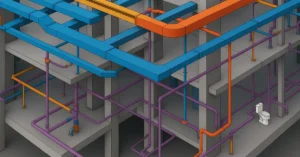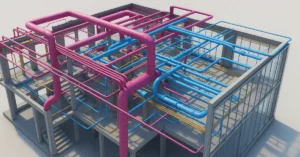Leading BIM Innovations in US Projects
In the dynamic landscape of the United States construction industry, Building Information Modeling (BIM) has emerged as a transformative force, revolutionizing the way projects are planned, designed, and executed. This article explores the latest innovations in BIM technology, highlighting their impact on efficiency, collaboration, and sustainability within the US construction sector.
Understanding Building Information Modeling (BIM)
Building Information Modeling (BIM) is an advanced digital process that involves creating and managing 3D models of construction projects. Unlike traditional CAD (Computer-Aided Design), BIM integrates data and information to support decision-making throughout the project lifecycle—from initial design to construction and facility management. BIM’s ability to provide a holistic view of a project improves coordination among stakeholders and enhances project outcomes.
Current Trends in BIM Adoption
- Integration with IoT and AI BIM’s integration with Internet of Things (IoT) devices and Artificial Intelligence (AI) enhances project monitoring, predictive analytics, and real-time decision-making. IoT sensors provide data on construction site conditions, while AI algorithms analyze this data to optimize construction processes and resource management.
- Cloud-Based Collaboration Cloud-based BIM platforms enable real-time collaboration among dispersed project teams. Stakeholders can access and update project information from any location, facilitating seamless communication and reducing delays in project timelines.
- Virtual and Augmented Reality (VR/AR) VR and AR technologies are revolutionizing project visualization and stakeholder engagement. BIM models can be visualized in immersive VR environments, allowing stakeholders to experience virtual walkthroughs of construction projects before physical construction begins.
Key Innovations in BIM Technology
- 4D and 5D BIM 4D BIM incorporates the element of time into 3D models, enabling project managers to visualize construction sequences and project schedules. 5D BIM goes further by integrating cost data, facilitating accurate cost estimation and budget management throughout the project lifecycle.
- Generative Design Generative design uses algorithms to explore multiple design options based on specified project parameters. BIM-enabled generative design enhances creativity and efficiency in architectural and engineering workflows, optimizing building performance and sustainability.
- Digital Twins Digital twins are virtual replicas of physical assets that use real-time data from sensors to simulate performance and predict maintenance needs. In construction, BIM-powered digital twins enable proactive asset management and lifecycle optimization, ensuring long-term sustainability and operational efficiency.
Case Studies: BIM in Action
- Hudson Yards, New York City Hudson Yards, one of the largest private real estate developments in the US, utilized BIM extensively for planning, design coordination, and construction management. BIM facilitated collaboration among multiple stakeholders, resulting in the timely delivery of iconic skyscrapers and public spaces.
- San Francisco Transbay Transit Center The Transbay Transit Center project in San Francisco employed BIM to manage complex design elements and construction logistics. BIM models were used to coordinate MEP (Mechanical, Electrical, Plumbing) systems and optimize spatial layouts, contributing to the project’s sustainability and operational efficiency.
- Los Angeles Rams Stadium The construction of the Los Angeles Rams Stadium exemplifies BIM’s role in sports facility development. BIM technology enabled precise coordination of architectural and structural elements, ensuring compliance with design specifications and enhancing spectator experience.
Future Directions and Challenges
- Advancements in AI and Machine Learning Continued advancements in AI and machine learning will further enhance BIM’s capabilities in predictive analytics, risk management, and automated decision-making. These technologies will drive efficiency gains and innovation in US construction projects.
- Standardization and Industry Collaboration Achieving standardization and interoperability among BIM platforms remains a challenge. Industry collaboration and alignment on BIM standards will be crucial for maximizing the benefits of BIM across the construction ecosystem.
- Cybersecurity and Data Privacy As BIM relies on digital data and cloud-based platforms, cybersecurity threats and data privacy concerns are significant considerations. Strengthening cybersecurity measures and implementing robust data governance frameworks are essential to protect sensitive project information.
Conclusion
Building Information Modeling (BIM) continues to redefine the US construction industry by fostering innovation, improving project outcomes, and advancing sustainability goals. As BIM technologies evolve and integrate with emerging trends such as AI, IoT, and digital twins, their transformative impact on construction processes and urban development will only grow stronger. By embracing BIM’s potential and addressing ongoing challenges, stakeholders in the US construction sector can position themselves at the forefront of innovation and leadership in the global construction landscape.
If you’re interested in learning more about architecture firms in Europe, check out this comprehensive list of the top 50 firms compiled by Archgyan. From innovative startups to long-established industry leaders, this list has it all. Take a look and discover some of the most inspiring and influential architecture firms in Europe today.
If you’re interested in architecture and want to learn more about this amazing field, subscribe to our podcast on youtube
For more SketchUp tutorials, head to https://www.sketchupguru.com










